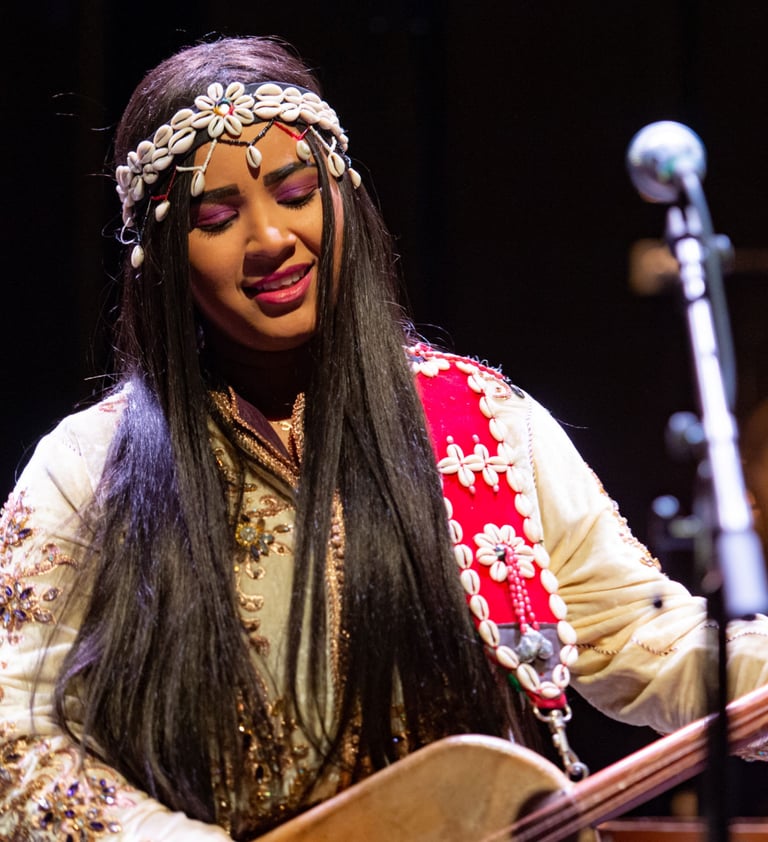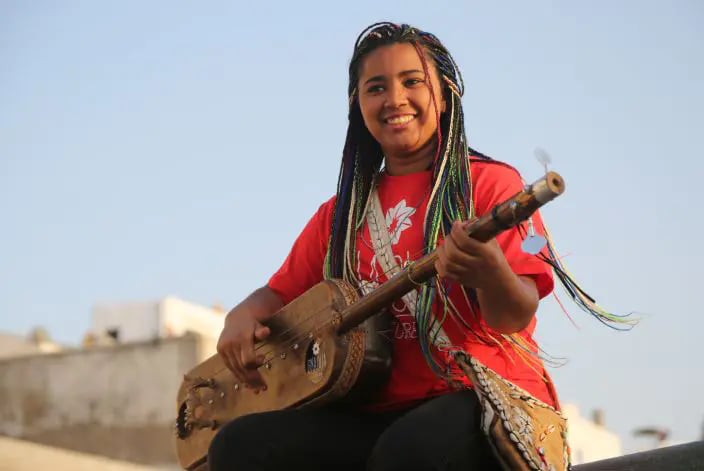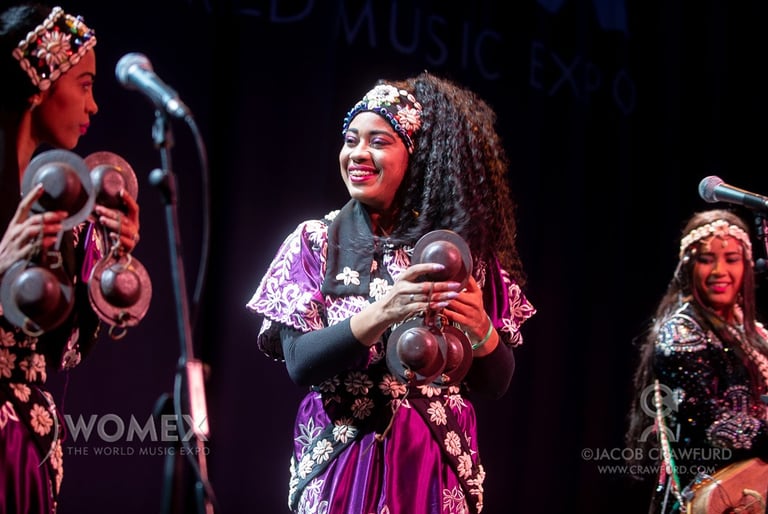The Fire of the Maâlema: Asmâa Hamzaoui and the Rebirth of Gnawa
How a young woman master is challenging centuries of tradition by championing its purest form, leading an all-female ensemble onto the world stage.


Introduction: A New Sound for an Ancient Rite
The scene is a major international festival, be it WOMAD in the UK or the legendary Gnaoua and World Music Festival in Essaouira. On stage, the low, pulsating hum of a guembri lays the foundation, a sound that seems to emerge from the depths of the earth. It is joined by the sharp, metallic chatter of the qraqebs, the iron castanets that hammer out a hypnotic rhythm. But the sight is what’s truly revolutionary: an all-female ensemble mastering a sacred musical tradition, led by a young woman whose warm, intense voice commands the group with the soul of the blues and the authority of a master. This is Maâlema Asmâa Hamzaoui with her band, Bnat Timbouktou.
Asmâa Hamzaoui is not merely a musician; she is a quiet revolutionary. She embodies a paradox: a staunch traditionalist who, by her very presence, is profoundly altering the landscape of her art form. This article will explore how Hamzaoui champions "transformation through conservation," inheriting a centuries-old tradition and projecting it into the future. Gnawa music—a spiritual and healing rite rooted in the history of sub-Saharan slaves in Morocco and now recognized by UNESCO as Intangible Cultural Heritage—has found in her a new, unexpected guardian.
A Predestined Birth
Born in Casablanca in 1998, Asmâa Hamzaoui entered not just a family, but the beating heart of the Gnawa tradition. Her father is the celebrated Maâlem (Master) Rachid Hamzaoui, and her mother a dancer of Saharawi descent. This lineage meant that Gnawa music wasn't just an art to be learned; it was the very air she and her older sister, Aicha, breathed from childhood.
Her training on the guembri, the sacred three-stringed bass lute traditionally reserved for men, began unconventionally. Her father started teaching her when she was just six or seven, a conscious and progressive act. Asmâa recalls that her father felt "great pride and joy in seeing us excel," caring more for her dedication than her gender. Maâlem Rachid Hamzaoui, seeing in his daughter the true heir to his musical and spiritual knowledge, became a revolutionary himself, allowing his legacy to flourish through her.
The moment that sealed her destiny came at age twelve. After taking her on tour, her father bequeathed his own guembri to her—an act of immense cultural weight, symbolizing the transfer of the title of maâlem (or, in her case, maâlema).
The Voice on the World Stage
Her appearances at the Gnaoua and World Music Festival in Essaouira, starting in 2017, marked a turning point, cementing her legitimacy in a male-dominated world. From there, her journey took her to prestigious international stages, including WOMAD and Roskilde Festival.
Key collaborations have further amplified her profile, including memorable performances with Malian superstar Fatoumata Diawara and the pan-African supergroup Les Amazones d'Afrique. These partnerships highlighted a deep spiritual and artistic connection among female artists carrying the torch for African musical traditions.

Bnat Timbouktou: Forging a Sisterhood in Sound
In 2012, Asmâa Hamzaoui founded her all-female group, Bnat Timbouktou (The Daughters of Timbuktu). Her public debut was met with a mix of astonishment and skepticism, but the power of her music soon won over even the staunchest critics.
Bnat Timbouktou is more than a band; it is a sisterhood. The core consists of Asmâa on lead vocals and guembri, with a collective of musicians providing the powerful rhythmic foundation with qraqebs and call-and-response vocals, most notably her sister Aicha. Their musical style is not a fusion, but 100% pure, traditional Gnawa, focused on the hypnotic, percussive groove.
The very existence of Bnat Timbouktou shatters convention. Historically in Gnawa culture, women were participants in the lila (trance ceremonies), but musical performance, especially on the guembri, was an exclusively male domain. Asmâa faced criticism but never wavered. "I was determined to enter this field despite the insults," she stated. "I hope to carry the torch and not disappoint my parents."
A Recorded Legacy: The Ajabu! Albums
Her two studio albums on the Swedish label Ajabu! Records are the definitive statements of her artistic vision. They are not mere collections of songs, but curated documents of her mission.
Oulad Lghaba (2019): The title, "Children of the Forest," refers directly to the historical roots of the Gnawa people. The album is a journey through the traditional repertoire, earning a nomination at the prestigious Songlines Music Awards and establishing her as a major international artist.
L'Bnat (2024): Meaning "The Daughters," this album is an explicit declaration of her mission. It centers on the female spirits and traditions within Gnawa culture, featuring tracks named after venerated female figures like 'Lalla Mira' and 'Lalla Aicha'. It is a conscious act of placing women at the heart of the spiritual narrative.
Her discography unfolds as a strategic two-act story. With Oulad Lghaba, she proved her mastery of the tradition, earning the right to speak as a maâlema. With the authority she had gained, she then made her bold feminist statement with L'Bnat.
Conclusion: Carrying the Fire into the Light
Asmâa Hamzaoui's success is monumental. She has challenged patriarchal norms not with rebellion, but with profound respect and virtuosic skill. Her work reminds the world that tradition is not a static museum piece, but a living, breathing entity that can evolve without losing its soul.
The final image is that of the maâlema on stage, the same as in the beginning. But now, the audience understands the weight of her journey: her father's legacy, the sisterhood of her band, and the profound cultural shift she represents. The fire of the Gnawa tradition, once passed only from father to son, is now carried forward, bright and blazing, in the hands of its daughters.




